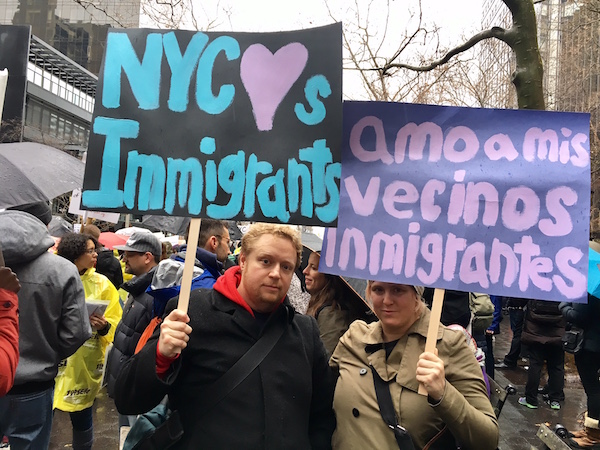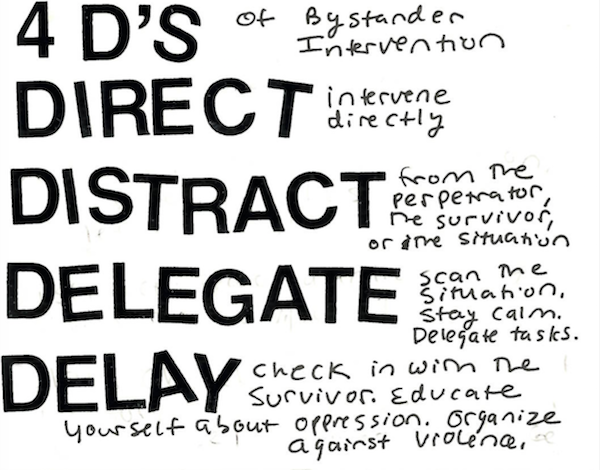
“So do you really choose to wear this thing? I mean does the Quran dictate that you must?” His insistent voice made its way through my headphones. I reluctantly I looked up from the book I was diligently reading on my late morning commute. A middle aged, white man, standing unsteadily, leaned close over two seated, young women wearing headscarves. The power dynamics were hard to ignore. I hit pause on my iPhone and took off my headphones. He kept on talking to the women, who looked at each other nervously, and kept trying to politely brush him off, saying, “It’s okay, we like it, it’s part of our culture.”
Sitting up straighter I looked steadily across the train car at the two women and said, “Do you want to have a conversation with this man?” They looked at me and shrugged, “No, it’s okay, we’re fine.” I smiled and nodded and said, “Okay, just wanted to make sure.” He kept talking to them, gesturing wildly.
I turned to him, “Excuse me sir, not everyone wants to talk to strangers on the subway. I like to be alone on my ride, which is why I am wearing headphones. I think these women would just like to continue their conversation with each other.”
He looked at me, as if he was surprised I noticed. I kept my gaze towards him steady. He moved away down the car and exited the at the next station.
After he left the women turned to me and said, “Thank you so much.”
I smiled, “Not a problem, I’m sorry that he was bothering you.”
When they got off at Jay Street Metrotech they waved and smiled and I waved back.
Ever since that day I’ve been so glad that I spoke up.
The above is an example of bystander intervention and verbal de-escalation that I engaged in last year. Since the election I have been horrified at the uptick of racist, homophobic, misogynist, and transphobic harassments and incidents that have transpired the around the country and right here in New York City. It’s angering and it’s maddening, but we have a power to stop these incidents when we see them by standing up and speaking out. Specifically, we can task ourselves with learning techniques and strategies to intervene safely while staying calm and centered as best we can.

I recently attended two trainings on bystander intervention and verbal de-escalation hosted by NYC Bluestockings books and the Arab American Association of New York. They were led social worker Rachel Levy, who has undertaken a huge task post-election to train people on how to go from being bystanders to “upstanders” – people equipped to stand up when they witness hate, violence, or bigotry, and use verbal techniques to de-escalate a situation. I got the idea for this zine before I attended the training, but my experience with these trainings reinforced why practicing these techniques is so vital to standing up against hate and creating the kind of inclusive, peaceful communities we want to live in.
If there is a training near you I highly recommend you go – it’s so important to be with other people post-election and realize that there are many of us who want to continue to stand up for justice and against hate and fear.
To reinforce what I learned in the training and to make a quick reference guide for others who want to equip themselves with the knowledge they need to intervene and de-escalate situations I made this one-page mini zine. In it you will find:

The four D’s of Bystander intervention:
- Direct – intervene directly.
- Distract – distract attention away from the perpetrator, survivor, or the situation. You might make yourself look silly, but you are making the situation safer.
- Delegate – scan the situation, stay calm, and delegate tasks as needed.
- Delay – check in with the survivor and make them feel valued. Education yourself about oppression. Organize for safer communities. Avoid victim blaming.
I also rounded up some verbal de-escalation strategies such as:
- Saying No – you always have the right to say no.
- Broken record – repeat the same statement like, “Stop talking to her, stop talking to her, stop talking to her…” until the perpetrator stops the behavior or leaves.
- Name the behavior – address the specific behavior of the perpetrator that is offensive. Such as, “You are yelling.” Avoid assumptions about their behavior or using sarcasm to address it. This gives the perpetrator an opportunity to correct their behavior.
- Use “I” statements – these enable you to state your feelings without judgment such as “I feel uncomfortable hearing that term.”
- Get to “we” or “forced teaming” – foster a sense of unity with the perpetrator, which helps avoid their anger getting directed towards you such as “We don’t talk to women that way.”
- Interrupt the situation or the perpetrator.
- Step it down – match the perpetrator’s intensity at first and then gradually lower your voice.
- Assertively ignore – chose to not engage as you assess the situation.
The techniques above are some of those practiced and taught by the Center for Anti-Violence Education, which also runs a website called Safe and Proud for LGBTQ youth. For more strategies and tactics I also recommend Creative Interventions. Showing Up for Racial Justice also has good resources, especially for other justice-oriented white people.

Overall, bystander intervention is about keeping yourself and others safe and supporting those who have been targeted by violence, hatred, or bigotry. It is not about “winning,” being a “hero,” or a “savior,” but doing the best you can in a tense situation to diffuse it. Anyone, regardless of their identity, can be a bystander or an upstander. However, the privileges you do and do not occupy will also impact how you are able to move through space and how you are perceived when you do and or do not intervene, and whether you are or are not targeted. Think about the intersection of identities you hold while thinking about how you can help work to make your community safe from hate and bigotry.
Please note that I am not an expert on bystander intervention and this is barely scratching the surface of very complex issues around power and violence. I am also writing it from my perspective of a white, middle-class woman living in a diverse, large city. However, I believe we all have a responsibility to support those who might be in more vulnerable positions than us post-election and to strive for a world free of bigotry, misogyny, and violence. Speaking up and taking day-to-day action can help.
Please feel free to download, copy on one piece of paper double sided, fold it up into a one-page book, and share this zine!
Not sure how to construct the zine once you’ve printed it on one, double-sided sheet of paper? This YouTube video demonstrates:
